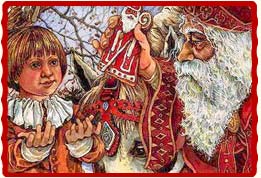Then they would eat a Twelfth Night cake and the person who found a bean or pea in their portion was chosen as the King and Queen for the day. The lucky person would then have the pleasure of being waited on by his/her master. Later, this evolved as the game known as 'charades', where the people would chose cards and would act as the characters noted on their cards for the whole of Twelfth Night. Today, the tradition of the Twelfth Night has slowly faded into history and it only the day to remove all Christmas decorations and the Christmas Tree from home. The religious significance of the twelve days of Christmas lies in the story of the Three Wise Men who arrived from the East with their gifts of gold, frankincense and myrrh to attend the infant Jesus. It is said that it took them twelve days to reach Him.
 In
the carol, two turtledoves represent the new and old testaments of the
Holy Bible while three French hens represent the theological virtues of
faith, hope and charity. Four calling birds are the four gospels of
Matthew, Mark, Luke and John. Five golden rings represent the
Pentateuch, the first 5 books of the old testament of Genesis, Exodus,
Leviticus, Numbers and Deuteronomy. Six geese-a-laying represent the
Biblical story of the six days of creation. Seven swans-a-swimming
symbolize the seven sacraments, the gifts of the Holy Spirit. Eight
maids-a-milking represent the eight beatitudes. Nine ladies dancing are
the nine fruits of the Holy Spirit while the Ten Lords-a-leaping are the
Ten Commandments. Eleven pipers are the eleven faithful apostles of
Jesus Christ and finally, the Twelve drummers are the twelve points of
principle of the Apostle's Creed.
In
the carol, two turtledoves represent the new and old testaments of the
Holy Bible while three French hens represent the theological virtues of
faith, hope and charity. Four calling birds are the four gospels of
Matthew, Mark, Luke and John. Five golden rings represent the
Pentateuch, the first 5 books of the old testament of Genesis, Exodus,
Leviticus, Numbers and Deuteronomy. Six geese-a-laying represent the
Biblical story of the six days of creation. Seven swans-a-swimming
symbolize the seven sacraments, the gifts of the Holy Spirit. Eight
maids-a-milking represent the eight beatitudes. Nine ladies dancing are
the nine fruits of the Holy Spirit while the Ten Lords-a-leaping are the
Ten Commandments. Eleven pipers are the eleven faithful apostles of
Jesus Christ and finally, the Twelve drummers are the twelve points of
principle of the Apostle's Creed.